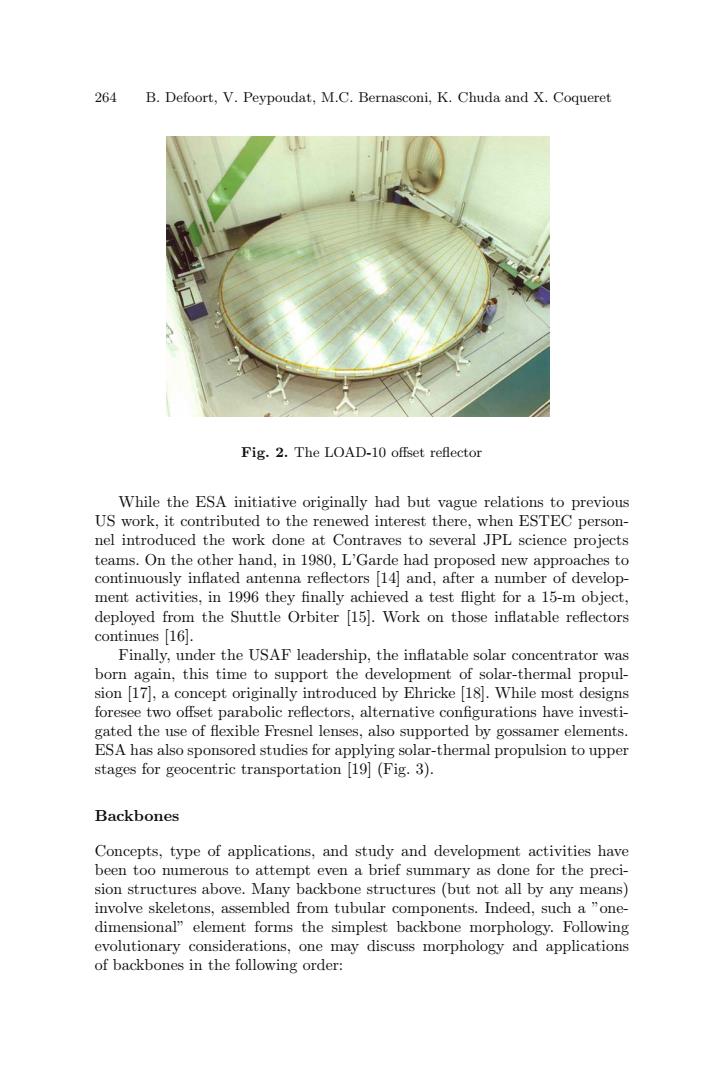正在加载图片...

264 B.Defoort,V.Peypoudat,M.C.Bernasconi,K.Chuda and X.Coqueret Fig.2.The LOAD-10 offset reflector While the ESA initiative originally had but vague relations to previous US work,it contributed to the renewed interest there,when ESTEC person- nel introduced the work done at Contraves to several JPL science projects teams.On the other hand,in 1980,L'Garde had proposed new approaches to continuously inflated antenna reflectors [14]and,after a number of develop- ment activities,in 1996 they finally achieved a test flight for a 15-m object, deployed from the Shuttle Orbiter 15.Work on those inflatable reflectors continues [16]. Finally,under the USAF leadership,the inflatable solar concentrator was born again,this time to support the development of solar-thermal propul- sion 17,a concept originally introduced by Ehricke [18.While most designs foresee two offset parabolic reflectors,alternative configurations have investi- gated the use of flexible Fresnel lenses,also supported by gossamer elements. ESA has also sponsored studies for applying solar-thermal propulsion to upper stages for geocentric transportation [19](Fig.3). Backbones Concepts,type of applications,and study and development activities have been too numerous to attempt even a brief summary as done for the preci- sion structures above.Many backbone structures (but not all by any means) involve skeletons,assembled from tubular components.Indeed,such a "one- dimensional"element forms the simplest backbone morphology.Following evolutionary considerations,one may discuss morphology and applications of backbones in the following order:264 B. Defoort, V. Peypoudat, M.C. Bernasconi, K. Chuda and X. Coqueret Fig. 2. The LOAD-10 offset reflector While the ESA initiative originally had but vague relations to previous US work, it contributed to the renewed interest there, when ESTEC personnel introduced the work done at Contraves to several JPL science projects teams. On the other hand, in 1980, L’Garde had proposed new approaches to continuously inflated antenna reflectors [14] and, after a number of development activities, in 1996 they finally achieved a test flight for a 15-m object, deployed from the Shuttle Orbiter [15]. Work on those inflatable reflectors continues [16]. Finally, under the USAF leadership, the inflatable solar concentrator was born again, this time to support the development of solar-thermal propulsion [17], a concept originally introduced by Ehricke [18]. While most designs foresee two offset parabolic reflectors, alternative configurations have investigated the use of flexible Fresnel lenses, also supported by gossamer elements. ESA has also sponsored studies for applying solar-thermal propulsion to upper stages for geocentric transportation [19] (Fig. 3). Backbones Concepts, type of applications, and study and development activities have been too numerous to attempt even a brief summary as done for the precision structures above. Many backbone structures (but not all by any means) involve skeletons, assembled from tubular components. Indeed, such a ”onedimensional” element forms the simplest backbone morphology. Following evolutionary considerations, one may discuss morphology and applications of backbones in the following order: